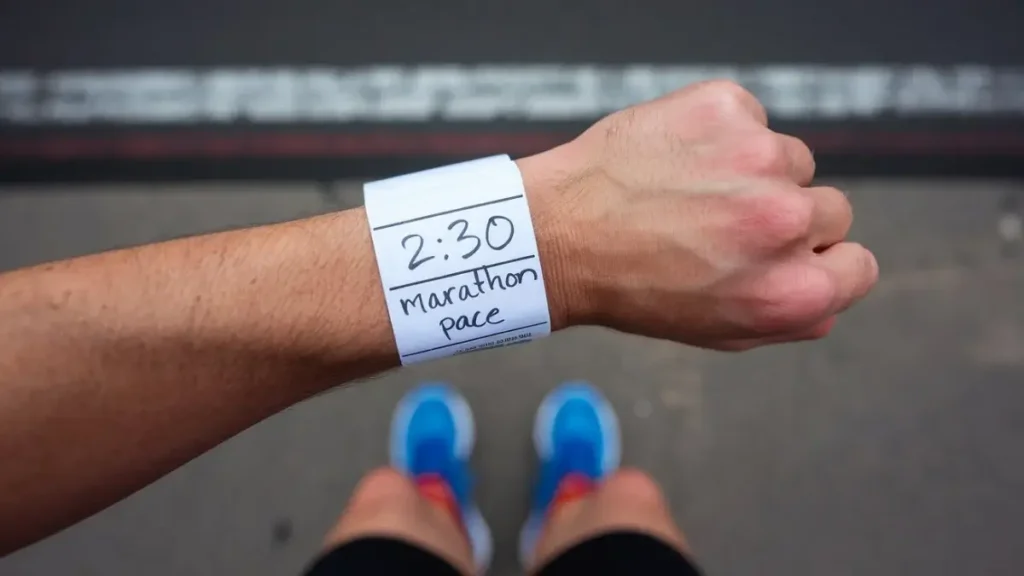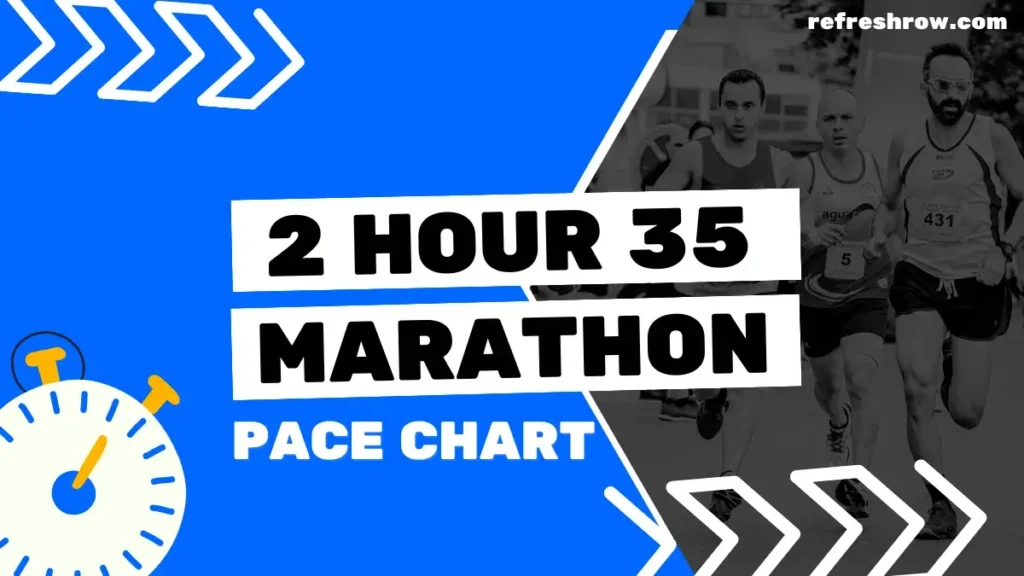To run a 5:30 hour marathon you need to run at a pace of 12:35 per mile or 7:49 per kilometer.
Following the splits below (and shaving off a second), you’ll run a sub 5:30 marathon.
I’d recommend aiming to run 1-2 minutes ahead of the split target time from 10 miles, as you’ll likely come up against crowding on race day.
5:30 Marathon Pace in Miles
| Mile | Split |
|---|---|
| 1 | 12:35 |
| 2 | 25:10 |
| 3 | 37:46 |
| 4 | 50:21 |
| 5 | 1:02:56 |
| 6 | 1:15:31 |
| 7 | 1:28:06 |
| 8 | 1:40:41 |
| 9 | 1:53:17 |
| 10 | 2:05:52 |
| 11 | 2:18:27 |
| 12 | 2:31:02 |
| 13 | 2:43:37 |
| 14 | 2:56:13 |
| 15 | 3:08:48 |
| 16 | 3:21:23 |
| 17 | 3:33:58 |
| 18 | 3:46:33 |
| 19 | 3:59:09 |
| 20 | 4:11:44 |
| 21 | 4:24:19 |
| 22 | 4:36:54 |
| 23 | 4:49:29 |
| 24 | 5:02:04 |
| 25 | 5:14:40 |
| 26 | 5:27:15 |
| 26.2 | 5:30:00 |
Download
5:30 Marathon Pace in KM
| KM | Split |
|---|---|
| 1 | 7:49 |
| 2 | 15:38 |
| 3 | 23:28 |
| 4 | 31:17 |
| 5 | 39:06 |
| 6 | 46:55 |
| 7 | 54:45 |
| 8 | 1:02:34 |
| 9 | 1:10:23 |
| 10 | 1:18:12 |
| 11 | 1:26:02 |
| 12 | 1:33:51 |
| 13 | 1:41:40 |
| 14 | 1:49:29 |
| 15 | 1:57:19 |
| 16 | 2:05:08 |
| 17 | 2:12:57 |
| 18 | 2:20:46 |
| 19 | 2:28:36 |
| 20 | 2:36:25 |
| 21 | 2:44:14 |
| 22 | 2:52:03 |
| 23 | 2:59:53 |
| 24 | 3:07:42 |
| 25 | 3:15:31 |
| 26 | 3:23:20 |
| 27 | 3:31:10 |
| 28 | 3:38:59 |
| 29 | 3:46:48 |
| 30 | 3:54:37 |
| 31 | 4:02:27 |
| 32 | 4:10:16 |
| 33 | 4:18:05 |
| 34 | 4:25:54 |
| 35 | 4:33:44 |
| 36 | 4:41:33 |
| 37 | 4:49:22 |
| 38 | 4:57:11 |
| 39 | 5:05:01 |
| 40 | 5:12:50 |
| 41 | 5:20:39 |
| 42 | 5:28:28 |
| 42.2 | 5:30:00 |
Download
Other Marathon Pace Charts
Targeting a different time?
Check out the Full Marathon Pace Chart in Miles or KM
Or select a specific finishing time below:
| 3:00 | 4:00 | 5:00 | |
| 3:05 | 4:05 | 5:15 | |
| 3:10 | 4:10 | 5:30 | |
| 3:15 | 4:15 | 5:45 | |
| 3:20 | 4:20 | 6:00 | |
| 3:25 | 4:25 | 6:15 | |
| 2:30 | 3:30 | 4:30 | 6:30 |
| 2:35 | 3:35 | 4:35 | 6:45 |
| 2:40 | 3:40 | 4:40 | 7:00 |
| 2:45 | 3:45 | 4:45 | |
| 2:50 | 3:50 | 4:50 | |
| 2:55 | 3:55 | 4:55 |
Training for a 5:30 Marathon
Is 5:30 a Good Marathon Time?
Well, what do the stats say?
Run Repeat conducted a study that contains 19,614,975 marathon results from more than 32,335 races across the globe, here is how a 5:30 marathon compares against age and gender for the races recorded:
| Overall | You’re faster than 13.1% of all runners. |
| Male | You’re faster than 8.9% of males. |
| Female | You’re faster than 18.5% of females. |
| <20 | You’re faster than 14.2% of under 20s. |
| 20-29 | You’re faster than 8.5% of 20-29 year olds. |
| 30-39 | You’re faster than 8.5% of 30-39 year olds. |
| 40-49 | You’re faster than 10.5% of 40-49 year olds. |
| 50-59 | You’re faster than 17.5% of 50-59 year olds. |
| >60 | You’re faster than 35.4% of over 60s. |
Training Runs and Paces for a 5:30 Marathon
To break a 5:30 marathon you’ll need to do some serious distance in your training, I recommend at least 10 miles (16km) per week.
You’re also going to need to make sure you’ve crossed off these milestones for other race distances:
- A 5k in 34:25
- A 10k in 1:11:40
- A half marathon in 2:30:00
Training Paces
| Pace | Mins per Mile | Mins per KM |
|---|---|---|
| Easy | 14:11 | 8:49 |
| Steady | 12:35 | 7:49 |
| 10k | 11:32 | 7:10 |
| 5k | 11:04 | 6:52 |
| 1 Mile | 10:17 | 6:25 |
Weekly Mileage Targets
| Target Mileage: | Gradually increase your weekly mileage from 10 miles (16 km) to a peak of 16 miles (26 km). |
| Incremental Increase: | Increase mileage by approximately 10% each week, with every fourth week as a recovery week where mileage is reduced by 20-30%. Make sure to taper for the last 1-2 weeks. |
Long Run Structure
| Total Distance: | Build up to long runs of 12-14 miles (19-22 km). |
| Segment Example: | First 5 miles (8 km): Easy pace, heart rate 140-150 bpm (approximately 15:00/mile or 9:19/km). Next 1 mile (1.6 km): Fast pace at 10:30/mile (6:32/km). Next 5 miles (8 km): Medium effort, heart rate around 160 bpm (approximately 11:30/mile or 7:09/km). |
Why This Works: Incorporating varied paces within long runs enhances lactate tolerance, which helps on race day when you’ve got to maintain pace despite feeling fatigued. By practicing surges during a run, you can build up your physical and mental resilience (lots of elite marathon runners use these strategies during their training)
Alternating Long Runs: Alternate between structured long runs (easy/fast segments) and easier long runs. For easier long runs, maintain a steady, comfortable pace throughout, focusing on mileage rather than speed to aid recovery.
Speedwork Sessions
| Short Intervals: | – 400m repeats at 5:10 per interval (6:27/km). – Aim for 6-8 repetitions with equal time for recovery. |
| Mile Repeats: | – 1 mile repeats at 10:30 per mile (6:32/km). – Aim for 3-4 repetitions with a 1-2 minute recovery jog. |
| Longer Intervals: | – 2 mile repeats at 10:45 per mile (6:41/km). – Aim for 2-3 repetitions with a 2-3 minute recovery jog. |
Recovery and Rest Days
| Rest Days: | Incorporate 1-2 rest days per week to allow your body to recover and prevent overtraining. |
| Easy Run Days: | Include 1-2 easy run days per week at a relaxed pace of 15:30/mile (9:38/km), covering 3-4 miles (5-6.5 km) per day. Try to keep your heart rate below 140 bpm on easy days to ensure proper recovery and aerobic development. |
My Tips to Run a Sub 5:30 Marathon
Try the “Negative Split” Strategy
The negative split strategy can be a lifesaver.
This means running the second half of the marathon slightly faster than the first half.
Start conservatively in the first half, focusing on a 12:45-12:50 pace to conserve energy.
In the second half, once your legs are warmed up, aim to first speed up to around 12:30 per mile, and then gradually increase to hit the 5:30 target.
This approach helps you finish the race feeling strong rather than struggling through the last miles.
Pay Attention to “Perceived Effort” Over Pace in the Final Miles
Most people find that their pace can start to fluctuate in the last few miles.
Instead of focusing on the exact pace per mile during these tough final miles, tune into how hard you feel like you’re working (your “perceived effort”).
If you feel like you’re pushing too hard, it’s okay to ease back a little, but if you’re feeling good, allow yourself to pick it up.
Keeping your effort level consistent, even if your pace varies, helps you finish strong and steady without overexerting yourself.
Build in Walk Breaks Early, Even If You Don’t Feel You Need Them
One of the biggest mistakes I see with beginners or slower-paced runners is waiting until they’re exhausted to start walking.
If you know you don’t need to walk, great.
If you know from your training walks are necessary:
Plan short walk breaks early in the race (say, every 2 miles) to help keep your legs fresh and prevent major slowdowns later on.
Even if you don’t feel like you need the breaks early on, they’ll pay off in the final miles when everyone else is starting to fade.
Consistent breaks help you control your pace and conserve energy, which will make the whole race more enjoyable.
Adjust for Course Elevation and Weather
Your pacing needs to be flexible based on conditions like hills or weather changes.
If you’re tackling a hilly course, it’s okay to slow down a bit on the inclines, and then regain time on the downhills.
If the weather is hot, consider slowing your target pace by 10-15 seconds per mile to compensate for the extra strain on your body.
The goal is to stay adaptable and adjust your pace based on the course and conditions, rather than rigidly sticking to a single pace.
Use Mile Markers as Mental Pacing Cues
A great way to stay on top of your pace is to use each mile marker as a check-in point.
After each mile, assess whether you’re on target for your goal pace.
If you’re slightly off, make small adjustments rather than trying to speed up drastically.
This method also helps break the marathon down into manageable pieces, giving you regular opportunities to assess and adjust your pacing strategy.
It can also take your mind off the strain of running, as you do your pacing maths in your head.


Row Brown is the founder of Refresh Row. He is a keen marathon runner, his favorite being the London Marathon. He’s now set himself the mission of Running the Entire Length of Spain, which is scheduled for late 2024.


